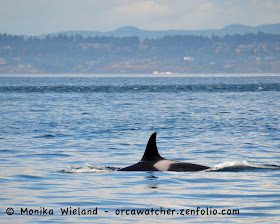When I used to just spend a few weeks up here every summer, being out every evening until after sunset was an almost nightly occurrence. Whether at American Camp or on the westside, or maybe up Mt. Young, I was always out enjoying the golden hour. Now that I live here, I still get out and about and enjoy the island all the time, but for some reason it seems I don't go for as many summer sunset hikes as when I was a visitor. This past weekend, after the disappointment of a shortened camping trip and after having slept the better part of the sunny afternoon away, Saturday evening seemed like the perfect time to go for a walk at American Camp.
I walked down to the point south of Granny's Cove, passing only one couple on the trail. As I sat down on the rocks, there was not another person in sight. The photo above was my view to the south. As I turned to the north, I saw a boat just begin to edge its way around the corner. I watched a few more moments, and sure enough, saw the distinct blow of an orca lit up from behind by the setting sun. I knew the L12s had been around, but again my timing was seemingly perfect. I saw for half an hour as part of the L12s (all but the L22s, I believe) made their way slowly south. They were all a good ways offshore, but in the glassy flat waters they were visible from far away, and the sound of their blows also carried loudly through the stillness.
L85 Mystery, pictured above, was the closest whale to shore at about 3/4 of a miles out.
While watching the whales, a bald eagle made a short flight out and back, passing right overhead int he process.
There were about 50 glaucous-winged gulls spread out on the water much closer to shore than the whales, taking advantage when possible of the 20 or so foraging rhinoceros auklets. When this one popped up right in front of me, I snapped this somewhat blurry picture that I just had to share to show how many bait fish he or she is holding in their beak. These guys stock up a mouthful to carry back to their nest burrows right before sunset. This one has at least 4 or 5 fish in its mouth, making it look like it's got a long, silvery mustache.
Oh yeah, the sunset wasn't too shabby either....
In addition to the whales, eagles, and other birds, I also saw a fox, a couple of deer, and a quick glimpse of what I think had to have been a mink. Why don't I do this more often again?






















.jpg)








.jpg)





















